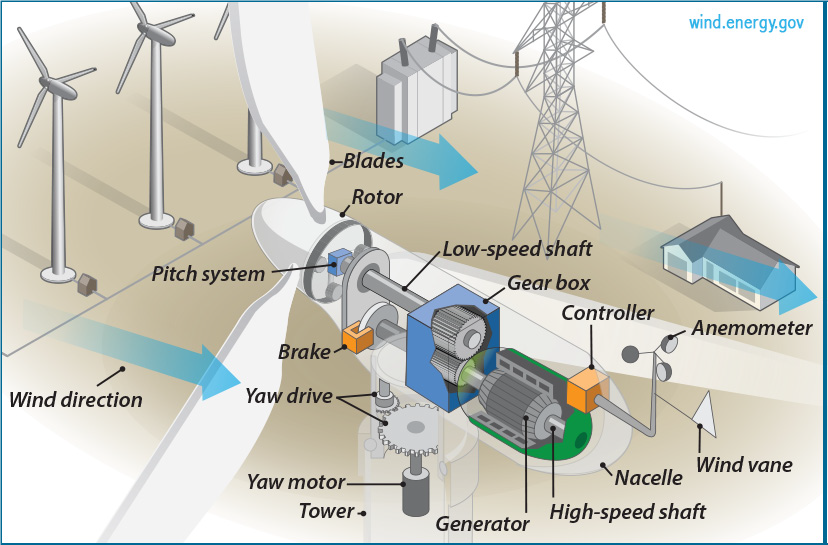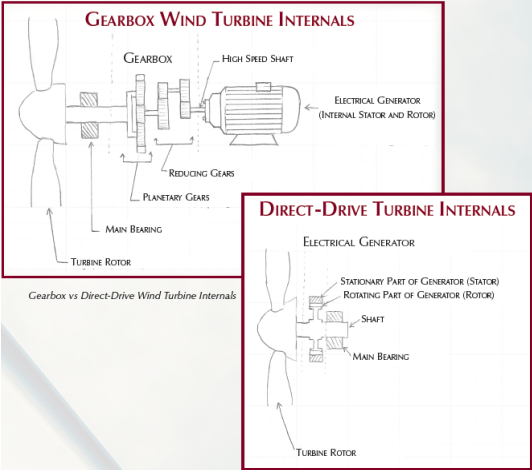Renewable Energy: Wind Turbines
Modern wind turbines
Wind turbines are a good example of how technology can be both simple and complex at the same time. From a distance, wind turbine blades spinning in the wind are akin to a child simply blowing on a pinwheel. Up close and inside the workings of a wind turbine, it becomes apparent that there are thousands of interconnected parts. Yet still, a wind turbine’s purpose remains simple: to turn wind into electrical energy.
In just four decades, wind turbine technology has gone from being a nostalgic element of a farm to a staple crop of U.S. energy production. Wind farms exist in almost every state, and the electricity they generate supplies 6.4 percent of U.S. energy needs.

How Do Modern Wind Turbines Work?
Key parts of a wind turbine include its tower, nacelle, hub, blades, and generator. The tower provides a stable and elevated platform for the nacelle. Since wind speed increases with height, towers are made taller to assist in capturing more wind energy. The nacelle is a streamlined enclosure that houses the turbine’s under-the-hood components including a generator, a cooling system, and a control system. The nacelle is connected to the tower in such a way that it can pivot to face any direction of the horizon. This is accomplished by its yaw drive system, which uses wind information to command a motor and gears to turn the nacelle into the wind. In other words, the yaw drive system makes the nacelle behave like a wind vane.
Attached to the front of the nacelle is the turbine’s hub. The turbine blades are connected to the hub where a pitch control mechanism adjusts the blades’ angle to expose more or less of their surface area to the wind. This control mechanism maximizes the wind force on the blades and thus the speed at which they spin. As the blades spin, they turn the hub, capturing the horizontal wind energy.
The under-the-hood components of the nacelle deliver this energy to the generator, also located in the nacelle, which turns the wind energy into electrical energy. Following a few additional electricity conditioning steps, this electricity is fed into the electric grid.
How Far Have Wind Turbines Come?
When one looks at wind turbine technology over the last eighteen years, it’s hard to not think of the 1990’s sitcom Home Improvement: “Bigger, better, and more power”. On average, the nacelle of today’s turbines stands an impressive 272 feet off the ground and has a blade rotational diameter of 354 feet. The circle these blades create as they spin has the same area as 1.7 football fields, including the end zones. Just as impressive, the average installed wind turbine in 2016 could power over 1700 homes, 2.3 times what an average turbine could power in the year 2000.
One of the recent developments in the wind turbine market is the elimination of a wind turbine’s gearbox. In the majority of the installed wind turbines, the rotational energy of the hub is translated through a gearbox and then delivered to the generator. The gearbox increases the speed of rotation much like a bicycle’s gears amplify the rate of its user’s peddling. This allows the relative slow rotation of the turbine to be increased to 1500 to 2500 rpm: the speed required by generators of that generation.
Advances in generator technology and the continual upscaling of the size of wind turbines has opened the market for what is known as direct-drive technology. In this type of wind turbine, the hub is connected to a permanent-magnet low-speed generator. This combination eliminates the need for the gearbox, removes over half of a wind turbine’s 8000 parts, and increases the reliability of the wind turbine. To date, two of the three largest manufacturers of U.S. installed wind turbines have direct-drive designs available for purchase, including land and offshore applications. In fact, the United States’ first offshore wind farm went online on December 12, 2016. This wind farm includes five General Electric, direct-drive wind turbines with a total electric output of 30 megawatts, enough to power 25,000 homes.
Industry Issues
One of the largest issues that the wind industry faces is its aging fleet of wind turbines. Government incentives created two previous installation booms that peaked in 2007 and 2011. Many of these turbines were designed to last 15-20 years, but have seen major component issues that have resulted in significant maintenance after 5-7 years. Advancements in reliability and service-focused design are continuing to improve modern wind turbines. Nonetheless, the recent addition of offshore wind turbines should be expected to spawn new issues associated with the new operating environment.
What Does the Future Hold?
The 2015 extension of government incentives, coupled with improvements in wind turbine cost and performance, have created a third boom in wind turbine installations. This boom is predicted to last until 2020. Turbines will continue to grow in size, power output, and the diversity of environments in which they’re installed. With this will come new engineering challenges in the fields of design, maintenance, and repair. All the while, clean and renewable energy will continue to be pulled from the wind.
Learn more about EDT’s mechanical engineers, technical consulting, and forensic engineering work.
Source: U.S. Department of Energy, 2016 Wind Technologies Market Report, Published August, 2017.


